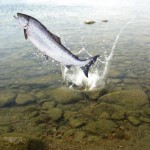
Shortly after John Mensinger and Larry Byrd blew the wheels off the Modesto Irrigation District (MID) water sale bandwagon and the City of Modesto looked likely to sue to assure its water rights, the Modesto Bee opined that, given the intense controversy surrounding the water sale, it couldn’t hurt to form a citizens’ advisory committee of agricultural and urban customers to help steer the water sale controversy to a reasonable conclusion.
As we’ve written here, there was a time when the Bee had an environmental conscience. In those days, the only game in town was committed not only to ag and urban interests but also to the general well-being of the environment, especially insofar as it concerned air, water, and wildlife.
Things are different now. Today’s Bee has yet to inform its readers of the Environmental Protection Agency’s “Impaired” ruling on the Tuolumne River, and the almost certain ensuing decree that much more water must be released along the Tuolumne to ensure adequate habitat requirements for fish and wildlife, especially salmon.
For anyone wishing a preview of the consequences when we neglect our rivers, just consider Jeff Denham’s frantic efforts to overturn federal rulings concerning the San Joaquin River. After decades of litigation, water is finally flowing along the sixty mile stretch of the San Joaquin that for countless years routinely ran dry. The intention is to restore life to the River and bring back historic Steelhead runs, among other things.
Congressman Denham is trying to roll back portions of the verdict on grounds that we can’t afford them. Many suspect he’s simply representing corporate interests that begrudge water for any uses other than their own.
Restoration of the San Joaquin River was ordered in large part because United States citizens overwhelmingly support conservation of rivers, fisheries, and endangered species. And while they don’t often have a media presence, citizens of the Northern San Joaquin Valley have played major parts in preservation of our region’s natural history.
For decades, the Sierra Club’s Bob Hackamack almost single-handedly defended the Tuolumne River against any number of depredations, and managed ultimately to achieve special protection in the form of “Wild and Scenic” status. The local Audubon chapter signed on early to the lawsuit that would restore the San Joaquin River and has been an active participant in the creation and expansion of the San Joaquin River National Wildlife Refuge since its inception.
Given the Tuolumne River’s fragile health and “Impaired” status, no one should be surprised when state and federal agencies require increased flows along the Tuolumne River. Part of the reason for the MID’s “hurry up and sell” strategy is the knowledge that the increased flow requirements will be large—most likely much larger than anyone can presently guess; they could result in less water available when the MID is up for relicensing.
The players in the MID water sale game include those citizens who see the river as much more than a lifeless conduit for ag and urban use. Despite attempts to deal them out, they, as well as the fish and wildlife that depend on the River, will be well represented with or without seats at the MID advisory table because they’ll be present in the both in the spirit and the letter of the law. And if the past offers any precedent, the fish will have their water.

I am not sure what this article is trying to purport. I know that in times of no dams, the rivers all but dried up during the summer after the snow melted and ground water leached out to an equilibrium. I see “large” summer flows as not natural. You think?
The historic salmon runs were during spring and fall. A major issue for the Tuolumne today is high temperatures; more water needs to be released to provide suitable temperaures for cold water fish.
229329 124117You should participate in a contest for probably the greatest blogs on the web. I will recommend this web website! 57641